Few fruits are as universally loved as strawberries. Sweet, juicy, and bursting with flavor, these red gems can be enjoyed fresh, in smoothies, on desserts, or even preserved as jams. The great news is that you don’t need a sprawling backyard or a large garden to grow them. With the right approach, strawberries can thrive beautifully in containers, making them perfect for patios, balconies, rooftops, and even small indoor spaces.
This guide will take you step by step through the process of growing strawberries in containers—covering everything from choosing the right varieties and containers to planting, care, and harvesting. By the end, you’ll be equipped with all the knowledge you need to grow your own sweet harvest.
Why Grow Strawberries in Containers?
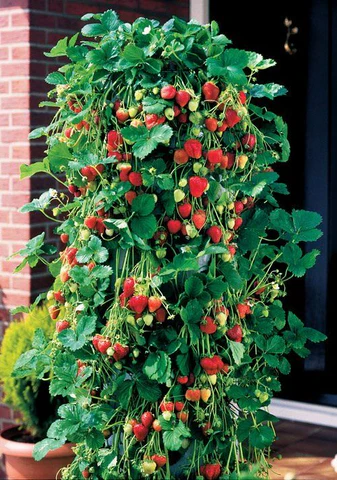
Growing strawberries in containers offers several advantages over traditional garden planting:
- Space-saving: Perfect for people with limited space like balconies, patios, or small yards.
- Better control: You can control soil quality, watering, and drainage more effectively.
- Reduced pests and diseases: Containers elevate plants, protecting them from soil-borne diseases, slugs, and weeds.
- Mobility: You can move containers to follow the sun or bring them indoors during harsh weather.
- Aesthetic value: Hanging baskets, tiered planters, and decorative pots filled with strawberry plants add beauty to your space.
Choosing the Right Strawberry Variety
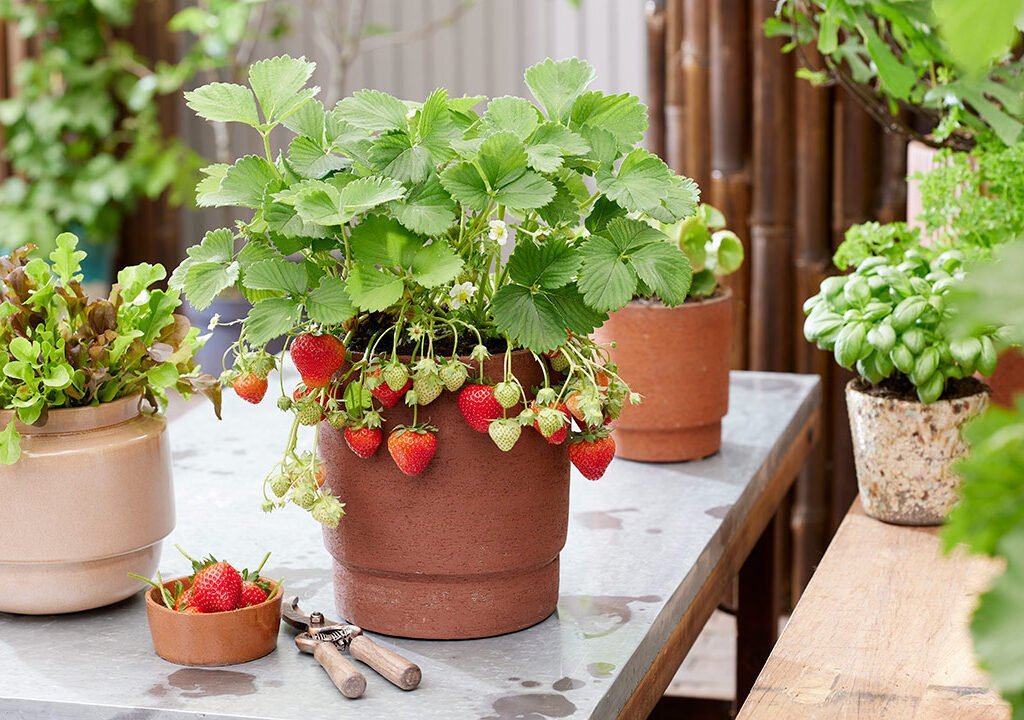
Not all strawberries are equally suited for container growing. Here are the main types:
- June-bearing strawberries
- Produce a large harvest once a year (late spring to early summer).
- Best if you want a big seasonal crop.
- Everbearing strawberries
- Produce two to three smaller harvests throughout the growing season.
- Great choice for a continuous supply of fruit.
- Day-neutral strawberries
- Produce consistently throughout the season, regardless of day length.
- Ideal for container growing as they provide fruit almost all season long.
Best varieties for containers: ‘Tristar,’ ‘Albion,’ and ‘Seascape’ are popular container-friendly options.
Choosing the Right Container
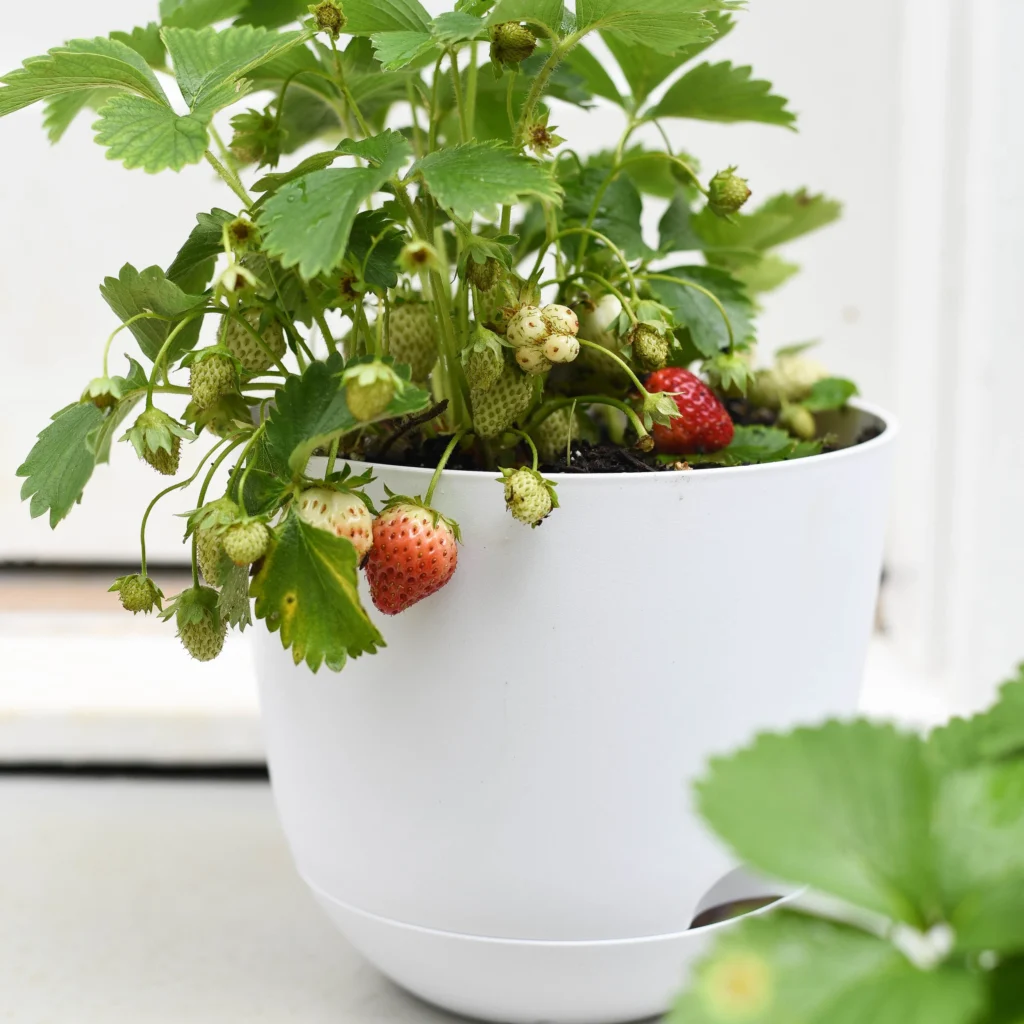
The container you choose plays a huge role in how well your strawberries grow.
- Size: A container should be at least 12–14 inches wide and 8–10 inches deep. Each plant needs about 8–12 inches of space.
- Material: Terracotta, plastic, fabric grow bags, and ceramic pots all work, as long as they have good drainage.
- Drainage: Proper drainage holes are crucial to prevent root rot.
- Specialty containers:
- Hanging baskets – Great for saving space and creating decorative displays.
- Strawberry jars – Pots with side openings designed specifically for strawberries.
- Tiered planters – Allow you to grow multiple plants vertically.
Preparing the Soil
Strawberries need rich, well-draining soil to thrive.
- Soil mix: Use a mix of high-quality potting soil, compost, and perlite or sand for good aeration.
- pH level: Strawberries prefer slightly acidic soil with a pH between 5.5 and 6.5.
- Fertilization: Mix in a slow-release organic fertilizer before planting to give plants a nutrient boost.
How to Plant Strawberries in Containers
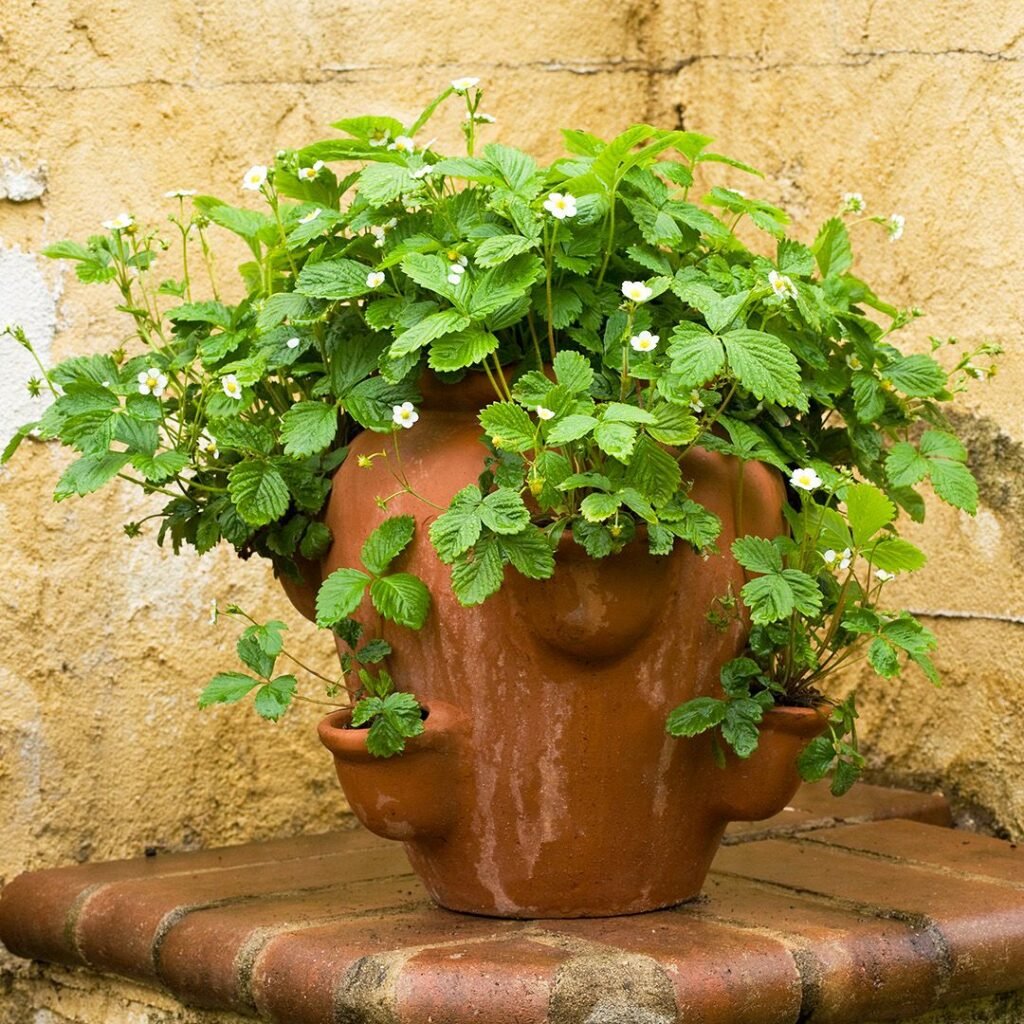
- Choose healthy plants
- Purchase certified disease-free seedlings or bare-root plants from a trusted nursery.
- Prepare the container
- Fill with your potting mix, leaving about 2 inches of space at the top.
- Plant correctly
- Place the strawberry plant so that the crown (where leaves meet roots) is level with the soil surface.
- Do not bury the crown, as this can cause rotting.
- Spacing
- Plant 1–3 plants per 12-inch container.
- In larger containers, space plants 8–12 inches apart.
- Water thoroughly
- After planting, water well to settle the soil around the roots.
Caring for Strawberries in Containers
1. Sunlight
Strawberries need at least 6–8 hours of direct sunlight daily. Place containers in the sunniest spot available. If growing indoors, consider supplementing with grow lights.
2. Watering
- Strawberries like consistent moisture but dislike soggy soil.
- Water when the top inch of soil feels dry.
- Use drip irrigation or a watering can to avoid wetting the leaves, which can cause fungal diseases.
3. Fertilizing
- Feed plants with a balanced liquid fertilizer every 3–4 weeks during the growing season.
- Avoid over-fertilizing, as this promotes leafy growth at the expense of fruit.
4. Mulching
- Add straw, pine needles, or shredded leaves around plants to keep soil moist and protect fruit from touching the soil.
5. Pruning and Runners
- Remove yellow or dead leaves to maintain plant health.
- Pinch off runners (long stems with baby plants) unless you want to propagate more plants. Runners can drain energy from fruit production.
Pests and Diseases
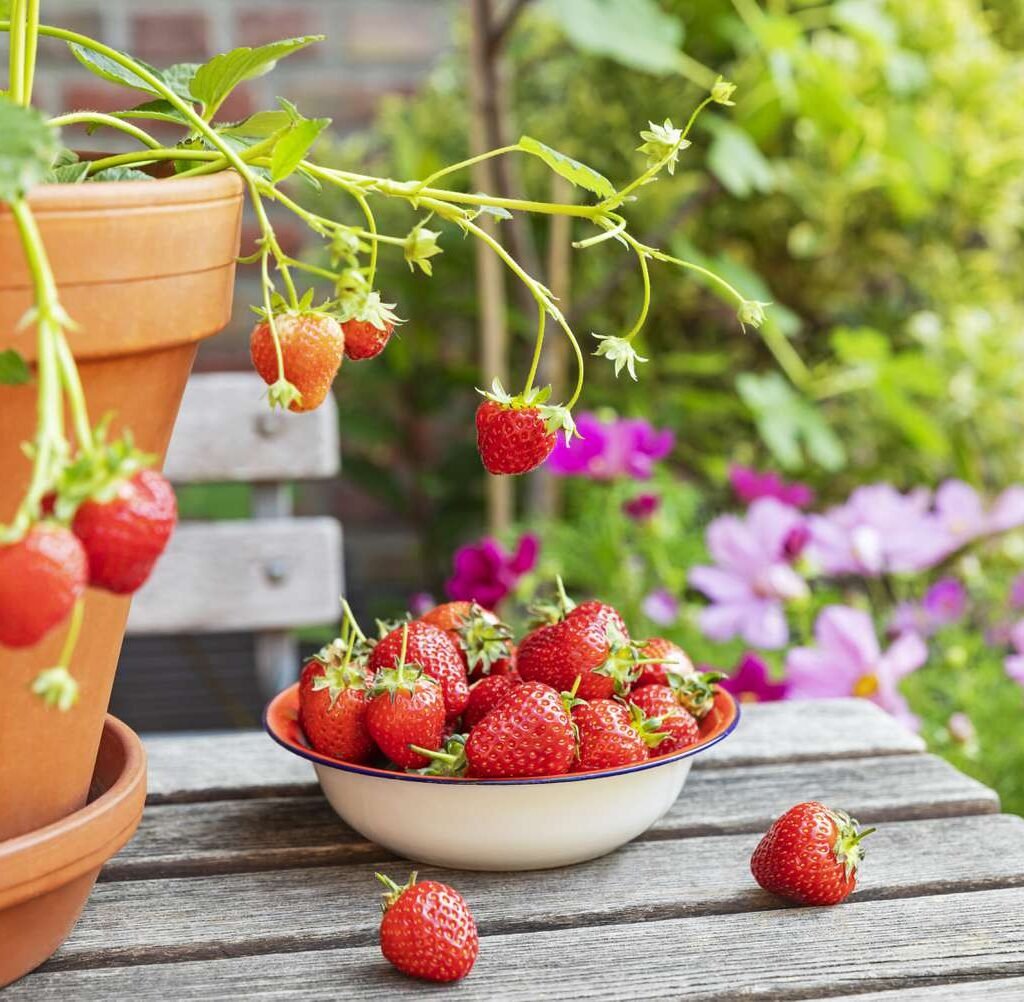
While container-grown strawberries face fewer problems than ground-grown ones, they can still attract pests:
- Pests: Aphids, spider mites, and slugs may appear. Use neem oil or insecticidal soap for control.
- Birds: Birds love strawberries—use netting or row covers to protect your fruit.
- Diseases: Powdery mildew and gray mold can occur. Ensure good airflow and avoid overhead watering.
Overwintering Strawberries in Containers
Strawberries are perennial plants, but container-grown ones need extra care in winter.
- In cold climates, move containers to an unheated garage, shed, or basement where temperatures stay just above freezing.
- Mulch heavily with straw to insulate roots.
- In warmer climates, strawberries can often remain outside year-round.
Harvesting Strawberries
Harvesting strawberries is one of the most rewarding steps.
- When to harvest: Pick berries when they are fully red, firm, and shiny.
- How to harvest: Gently twist or snip the stem just above the berry to avoid damaging the plant.
- Frequency: Check plants every 2–3 days during peak season, as berries ripen quickly.
Storing and Using Strawberries
- Fresh use: Eat immediately for the best flavor.
- Refrigeration: Store unwashed berries in the fridge for 2–3 days.
- Freezing: Wash, hull, and freeze strawberries on a baking sheet before transferring to freezer bags.
- Preserving: Make jams, jellies, or syrups to enjoy year-round.
Common Mistakes to Avoid
- Overcrowding plants – Leads to poor airflow and disease.
- Overwatering – Causes root rot.
- Using garden soil – Too heavy and compact for containers. Always use potting mix.
- Ignoring runners – They sap energy from fruit production if not removed.
- Lack of sunlight – Plants won’t produce well without 6–8 hours of sun.
Benefits of Container-Grown Strawberries
Growing strawberries in containers isn’t just practical—it’s fun and rewarding. Benefits include:
- Fresh, organic fruit at your fingertips.
- Ability to grow strawberries in any space, no matter how small.
- Fewer weeds and easier maintenance compared to in-ground beds.
- A beautiful decorative element for your home or garden.
Final Thoughts
Strawberries are one of the easiest and most rewarding fruits to grow in containers. With the right variety, container, soil mix, and care routine, you can enjoy a steady supply of sweet, juicy berries right outside your door. Whether you’re a beginner gardener or an experienced grower looking for space-saving options, container strawberries make an excellent choice.
Not only will you enjoy delicious harvests, but you’ll also add beauty and greenery to your living space. Start with just a few plants, give them the care they need, and before long, you’ll be savoring homegrown strawberries that taste better than anything from the store.
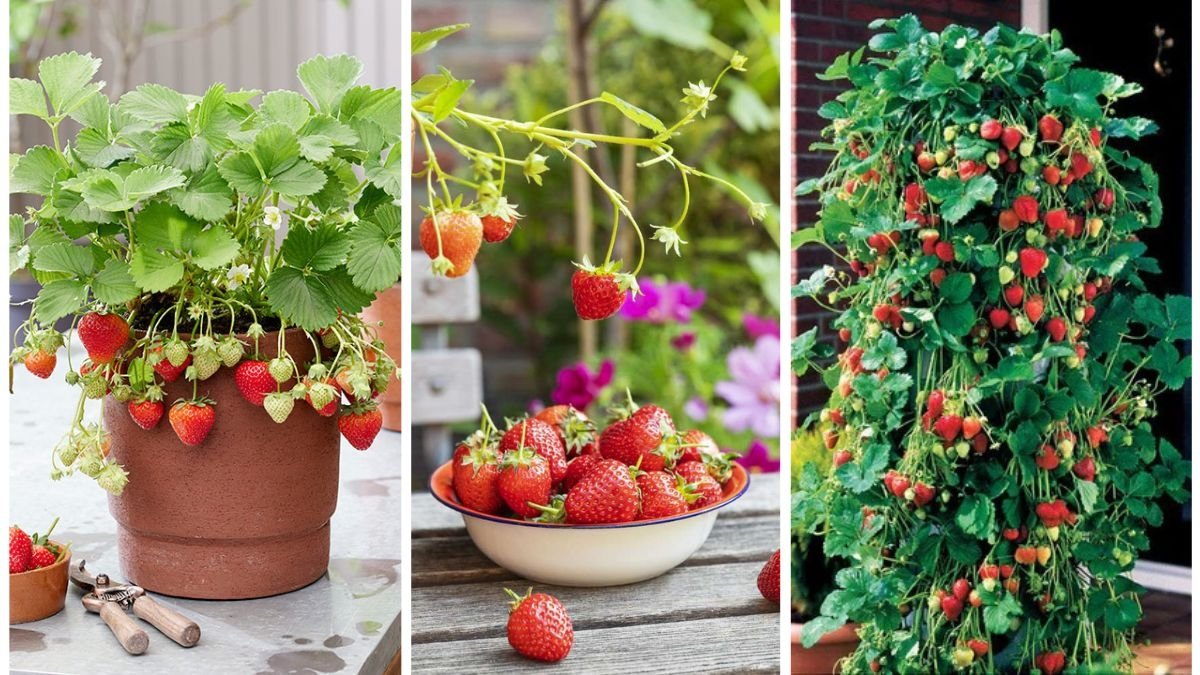




Leave A Comment